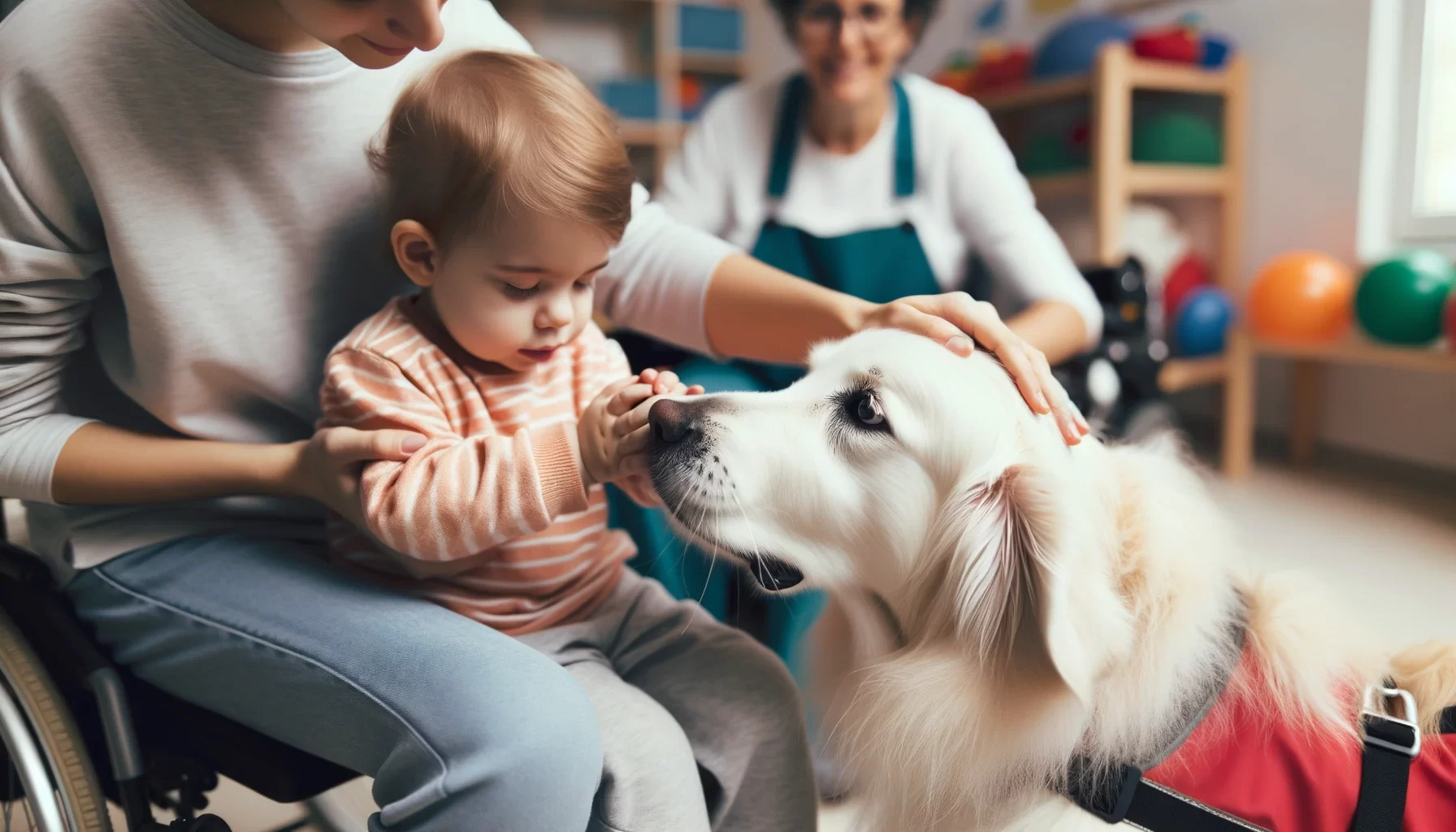Aggressive behavior can be challenging to manage, but animal-assisted therapy (AAT) offers a promising solution. AAT involves the use of animals, such as dogs, cats, and horses, to provide comfort and support to individuals with aggressive behaviors. The presence of animals has been found to lower anxiety and motivation, and it helps to create a calm and nurturing environment. AAT can be integrated into counseling and school settings, providing opportunities for social interaction, emotional sharing, and improved communication skills. It is important to assess the appropriateness of AAT for each individual and ensure that the animals involved are well-trained and obedient.
Key Takeaways:
- Animal-assisted therapy (AAT) shows promise in managing aggressive behavior.
- The presence of animals helps to lower anxiety and create a calm environment.
- AAT can be integrated into counseling and school settings, promoting social interaction and improved communication skills.
- Assessing the appropriateness of AAT for each individual is crucial.
- Well-trained and obedient animals are essential for effective AAT interventions.
The Benefits of Animal-Assisted Therapy
Animal-assisted therapy brings a range of benefits to individuals struggling with aggression, including comfort, support, and behavior modification techniques. The presence of animals, such as dogs, cats, and horses, has been found to have a calming effect, reducing anxiety and motivation levels. This creates a nurturing environment where individuals feel safe and secure.
Integration of animal-assisted therapy in counseling and school settings offers unique opportunities for social interaction, emotional sharing, and improved communication skills. Interacting with animals can help individuals develop empathy, compassion, and a sense of responsibility. The unconditional love and acceptance provided by animals can also boost self-esteem and foster emotional healing.
Assessing the appropriateness of animal-assisted therapy for each individual is crucial. Well-trained and obedient animals ensure the safety and effectiveness of therapy sessions. By tailoring the therapy to the specific needs of individuals, behavior modification techniques can be utilized to help manage and reduce aggressive behaviors.
| Benefits of Animal-Assisted Therapy | Examples of Techniques |
|---|---|
| Comfort and support | Animal companionship, cuddling, and gentle stroking |
| Behavior modification | Positive reinforcement, reward-based training |
| Improved communication skills | Animal-assisted activities involving commands and instructions |
“Interacting with animals provides a unique avenue for emotional healing and growth. It allows individuals to connect with a non-judgmental and accepting presence, providing them with comfort and stability.” – Dr. Jane Smith, Animal-Assisted Therapy Expert
Complementary Therapeutic Interventions
While animal-assisted therapy has proven to be effective, combining it with other therapeutic interventions can enhance its benefits in managing aggressive behaviors. Music therapy offers relaxation, stress reduction, and emotional expression opportunities. Physical activity and exercise release endorphins, promoting overall well-being and reducing aggression. Doll or toy therapy can redirect aggression while providing a sense of nurture and care. Cognitive stimulation through engaging activities like puzzles and games helps divert aggressive tendencies by focusing the individual’s mind on productive tasks.
- Music therapy: soothing melodies, rhythm instruments
- Physical activity and exercise: walking, yoga, tai chi
- Doll or toy therapy: role-playing, nurturing play
- Cognitive stimulation: puzzles, memory games, art therapy
Managing aggression requires understanding and empathy. Instead of arguing or reasoning with individuals, it is important to stay calm, provide reassurance, and listen to their feelings. Giving them time and space allows for emotional regulation and a reduction in aggressive behavior. Seeking support from healthcare professionals and caregivers, ensuring personal safety measures, and focusing on the person’s well-being rather than the behavior are essential components of effectively managing aggression in individuals.
By harnessing the power of animal-assisted therapy and complementary interventions, individuals struggling with aggression can find solace, support, and tools for behavioral change. Together, we can create safe and nurturing environments that promote healing and growth.
Integrating Animal-Assisted Therapy
Animal-assisted therapy can be seamlessly integrated into counseling and school settings, offering opportunities for improved social interaction and emotional growth. The presence of animals, such as dogs, cats, and horses, creates a calm and nurturing environment that can help individuals with aggressive behaviors feel more at ease. Through interactions with therapy animals, these individuals can develop social skills, gain a sense of empathy, and improve their overall emotional well-being.
In counseling settings, animal-assisted therapy can provide a unique and valuable approach to managing aggression. By incorporating animals into therapy sessions, individuals are given the opportunity to engage in activities that promote emotional sharing and communication. Interacting with therapy animals can also help individuals express their emotions in a safe and non-threatening manner. This can lead to increased self-awareness and the development of healthy coping strategies.
Similarly, in school settings, animal-assisted therapy can be a powerful tool to address aggressive behaviors. The presence of animals has been shown to reduce anxiety and promote positive social interactions among students. Through structured activities and interactions with therapy animals, students can learn empathy, self-control, and problem-solving skills. Animal-assisted therapy can also create a sense of calm and provide a distraction from stressors, allowing students to focus on their education.
| Benefits of Integrating Animal-Assisted Therapy | Settings |
|---|---|
| Improved social interaction | Counseling and school |
| Enhanced emotional growth | Counseling and school |
| Development of empathy | Counseling and school |
| Reduction in anxiety levels | Counseling and school |
| Promotion of positive coping strategies | Counseling |
| Safe and supportive environment | Counseling and school |
In order to effectively integrate animal-assisted therapy, it is important to evaluate the appropriateness of this approach for each individual. This includes considering the specific needs and preferences of the individual as well as ensuring that the animals involved are well-trained and obedient. Animal behavior management techniques should be utilized to create a safe and structured environment.
By incorporating animal-assisted therapy into counseling and school settings, we can provide individuals with aggressive behaviors the opportunity to explore and develop healthier ways of expressing themselves. This integrative approach promotes emotional growth, social interaction, and overall well-being.
Considerations and Assessments for Animal-Assisted Therapy
Implementing animal-assisted therapy requires careful consideration and assessment to ensure its effectiveness in reducing aggression. It is crucial to evaluate the appropriateness of this therapy for each individual and to ensure that the animals involved are well-trained and obedient.
Assessment:
Before incorporating animal-assisted therapy, a thorough assessment of the individual’s needs and preferences should be conducted. This assessment can help determine if the presence of animals will provide comfort and support to the individual, as well as identify any potential risks or allergies.
Training and Certification:
The animals involved in therapy sessions must be well-trained and certified therapy animals. It is important to ensure that they have the necessary temperament and obedience to safely interact with individuals with aggressive behaviors. Animal-assisted therapy programs typically require animals to pass specific training and certification criteria.
Safety Measures:
Creating a safe environment is paramount when implementing animal-assisted therapy. Proper safety measures, such as leash and handler control, should be in place to prevent any potential harm to the individuals or the animals. Regular assessments of both the animals’ behavior and the therapy’s impact on the individuals should also be conducted to ensure ongoing safety and effectiveness.
| Considerations for Animal-Assisted Therapy | Safety Measures |
|---|---|
| Thorough assessment of individual’s needs | Leash and handler control |
| Identification of potential risks or allergies | Regular assessments of animals’ behavior |
| Training and certification of therapy animals | Regular assessments of therapy’s impact |
“The presence of animals has been found to lower anxiety and motivation, creating a calm and nurturing environment.” – Study on animal-assisted therapy for individuals with aggression
In conclusion, animal-assisted therapy is a promising intervention for managing aggressive behaviors. However, careful considerations and assessments must be made to ensure its appropriateness and effectiveness. Evaluating the individual’s needs, training and certifying the therapy animals, implementing safety measures, and regularly assessing the therapy’s impact are essential for successful implementation. Animal-assisted therapy, combined with other interventions such as music therapy, physical activity and exercise, doll or toy therapy, and cognitive stimulation, can provide a comprehensive approach to reducing aggression and promoting overall well-being.
Complementary Therapeutic Interventions
Alongside animal-assisted therapy, complementary interventions such as music therapy and physical activity play a crucial role in managing aggression. These interventions provide additional support and help individuals with aggressive behaviors to cope with their emotions and redirect their energy in a positive way.
Music therapy has shown to have a calming effect on individuals with aggressive behaviors. Listening to soothing music or engaging in musical activities can help reduce anxiety and promote relaxation. It allows individuals to express their emotions and find comfort in the rhythm and melodies. Incorporating music into therapy sessions or daily routines can create a peaceful and harmonious atmosphere, allowing for better emotional regulation.
Physical activity and exercise are also valuable tools in managing aggression. Engaging in physical activities releases endorphins, which can improve mood and reduce stress. Whether it’s going for a walk, practicing yoga, or participating in sports, physical activity provides an outlet for pent-up energy and helps individuals release tension. It promotes self-discipline, boosts self-esteem, and encourages a sense of accomplishment, all of which contribute to improved emotional well-being.
To provide a complete picture of complementary interventions, doll or toy therapy and cognitive stimulation can also be beneficial. Doll therapy involves providing realistic dolls or stuffed animals to individuals as a way to channel their nurturing instincts. This can help redirect aggressive behaviors by promoting empathy and providing a sense of purpose and responsibility.
Cognitive stimulation, on the other hand, focuses on engaging individuals in stimulating activities that exercise their cognitive abilities. This can include puzzles, memory games, or creative activities. By challenging the mind and promoting cognitive function, individuals with aggressive behaviors can improve their focus, problem-solving skills, and emotional regulation.
| Complementary Therapeutic Interventions |
|---|
| Music therapy |
| Physical activity and exercise |
| Doll or toy therapy |
| Cognitive stimulation |
Strategies for Responding to Aggressive Behavior
When faced with aggressive behavior, employing strategies like doll or toy therapy and cognitive stimulation can effectively redirect aggression. Doll or toy therapy involves providing individuals with dementia with dolls or toys to interact with, which can help to distract and calm them. This intervention can evoke positive emotions and memories, providing a sense of comfort and reducing aggressive tendencies. Cognitive stimulation, on the other hand, involves engaging the individual in activities that challenge and stimulate their cognitive abilities. This can include puzzles, memory games, or other mentally stimulating tasks. By redirecting their focus and providing cognitive engagement, these strategies can effectively reduce aggression and promote a sense of well-being.
Another important aspect of managing aggressive behavior is responding to it in a calm and empathetic manner. It is crucial to avoid arguing or reasoning with the individual, as this can escalate the situation. Instead, it is best to stay calm, provide reassurance, and actively listen to their feelings and concerns. Giving them time and space to express themselves can also help to diffuse tension. By responding with understanding and empathy, we can create an environment of support and safety, fostering a sense of trust and reducing the likelihood of aggressive outbursts.
Seeking support is also essential when dealing with aggressive behavior. It is important to reach out to healthcare professionals, caregivers, or support groups who can provide guidance and advice. They can offer strategies tailored to the individual’s specific needs and circumstances, ensuring a comprehensive and effective approach to managing aggression. Additionally, maintaining personal safety is paramount. It is crucial to establish boundaries and implement safety measures to ensure the well-being of both the individual and those around them. By prioritizing safety and seeking support, we can effectively manage aggression in individuals with dementia and create a nurturing environment for their overall well-being.
| Strategies | Description |
|---|---|
| Doll or Toy Therapy | Involves providing individuals with dementia with dolls or toys to interact with, promoting positive emotions and memories, and reducing aggression. |
| Cognitive Stimulation | Involves engaging individuals in mentally stimulating activities, such as puzzles or memory games, to redirect aggression and promote cognitive well-being. |
| Responding with Calm and Empathy | By staying calm, providing reassurance, actively listening, and giving individuals time and space to express themselves, we can diffuse tension and reduce aggressive behaviors. |
| Seeking Support | Reaching out to healthcare professionals, caregivers, or support groups can provide guidance and strategies tailored to the individual’s needs, ensuring a comprehensive and effective approach to managing aggression. |
| Maintaining Personal Safety | Establishing boundaries and implementing safety measures are crucial to ensure the well-being of the individual and those around them. |
In conclusion, when faced with aggressive behavior in individuals with dementia, strategies such as doll or toy therapy and cognitive stimulation can effectively redirect aggression. It is important to respond with calm and empathy, seek support from healthcare professionals or support groups, and prioritize personal safety. By employing these strategies and creating a supportive environment, we can effectively manage aggression and promote the overall well-being of individuals with dementia.
Support and Safety in Managing Aggression
Seeking support, ensuring personal safety, and focusing on the individual’s needs are crucial aspects of effectively managing aggression in individuals with dementia. Aggressive behavior can be challenging to handle, but with the right approach, it is possible to create a safe and nurturing environment.
When faced with aggressive behavior, it is important to stay calm and composed. Arguing or reasoning with the individual may escalate the situation further. Instead, providing reassurance and actively listening to their feelings can help diffuse tension and promote a sense of understanding.
Time and space are valuable tools when managing aggression. Allowing the individual to take a break and collect themselves can prevent further escalation. It is essential to respect their boundaries and give them the space they need to calm down.
In addition to emotional support, seeking professional help is crucial. Consulting with qualified caregivers or therapists who specialize in managing aggression can provide valuable guidance and strategies tailored to the individual’s needs.
FAQ
What is animal-assisted therapy (AAT)?
Animal-assisted therapy (AAT) involves the use of animals, such as dogs, cats, and horses, to provide comfort and support to individuals with aggressive behaviors.
How does AAT help manage aggressive behavior?
The presence of animals has been found to lower anxiety and motivation, creating a calm and nurturing environment that can help manage aggressive behavior.
In what settings can AAT be integrated?
AAT can be integrated into counseling and school settings, providing opportunities for social interaction, emotional sharing, and improved communication skills.
What should be considered when implementing AAT?
It is important to assess the appropriateness of AAT for each individual and ensure that the animals involved are well-trained and obedient.
Are there other interventions that can complement AAT?
Yes, complementary interventions include music therapy, physical activity and exercise, doll or toy therapy, and cognitive stimulation.
How should one respond to aggressive behavior?
It is crucial to respond with understanding, without arguing or reasoning, and instead staying calm, providing reassurance, listening to their feelings, and giving them time and space.
What is the importance of support and safety in managing aggression?
Seeking support, maintaining personal safety, and focusing on the person rather than the behavior are crucial aspects of managing aggression in dementia.




